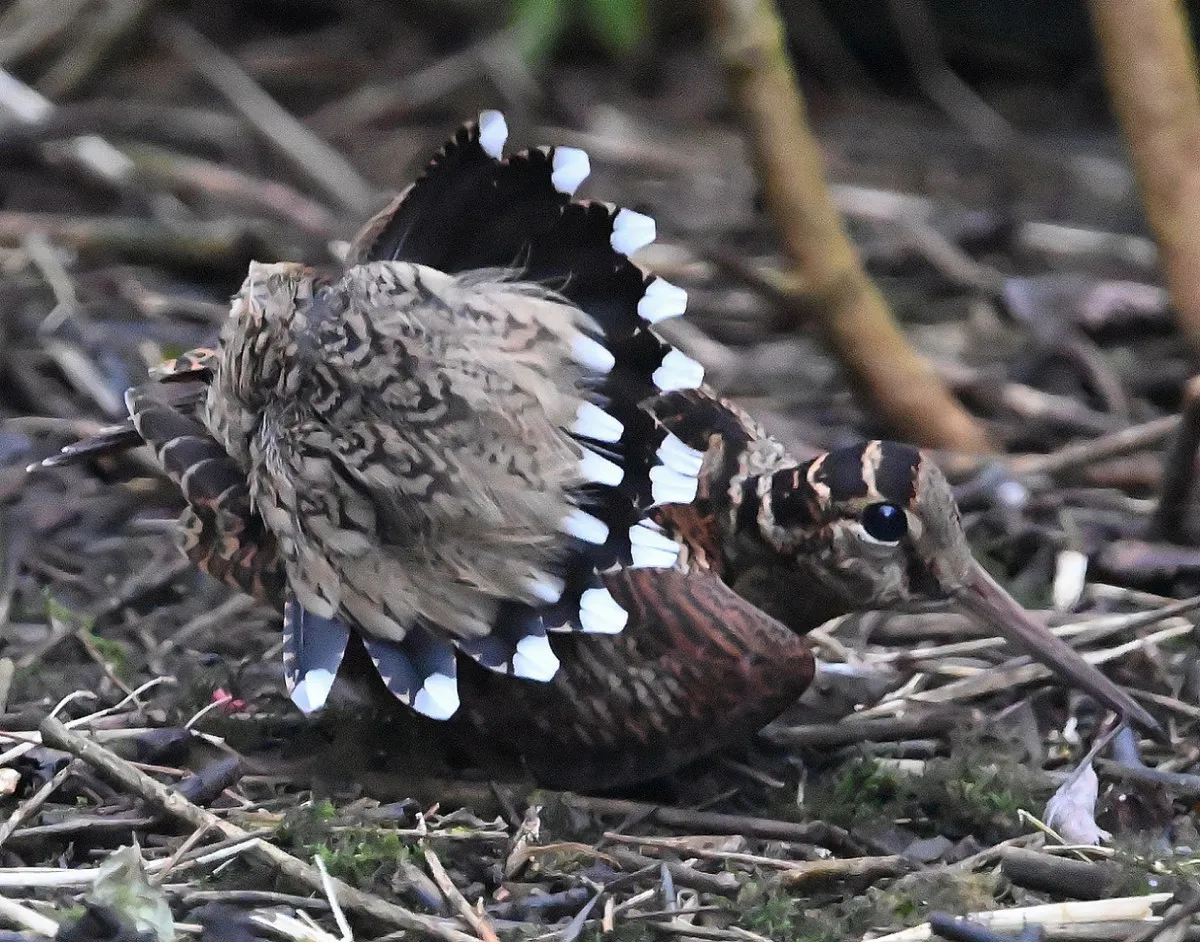Citation

Overview
Although the Woodcock is one of the world’s most abundant wading birds, Britain’s resident population has been declining since at least the end of the 1960s. Periodic Woodcock surveys began in 2003 and have been repeated in 2013 and 2023. This paper reports on the latest of these surveys.
In more detail
Breeding Woodcocks are difficult to monitor through traditional multi-species surveys because of their nocturnal behaviour and cryptic plumage. However, the males perform display flights during the breeding season, following circuitous and overlapping routes that may encompass many hectares of woodland habitat. This behaviour provides a useful means of monitoring the size of the breeding population.
Volunteers participating in the 2023 survey visited 1,230 randomly selected squares, with multiple visits made at dusk to each square over the core of the Woodcock breeding season. Survey coverage was greater and more evenly distributed than in previous surveys, providing the most robust estimate yet. The results from these visits were used to produce regional and national estimates of population size.
The British population was estimated at 50,750 males, representing an 8% decline since 2013, and a 35% decline since 2003. Despite small population increases in Wales and England since 2013, the continuing decline was driven by a 49.5% reduction in North Scotland’s population estimate. An estimate for Northern Ireland – the first produced using this species-specific method – gave a population of 937 males.
The results underline that our breeding Woodcock populations are continuing to decline, and provide important regional information that can be used to support land management and policy decisions. The Woodcock is hunted widely across Europe, and approximately 140,000 individuals are shot in the UK annually. The impacts of hunting on our breeding Woodcock populations are unclear, largely because the UK hunting season for Woodcock runs from October to the end of January, matching a period when our resident population is joined by very large numbers of wintering individuals from elsewhere in Europe. Having robust information on the breeding population provides vital evidence on the changing fortunes of this Red-listed Bird of Conservation Concern.
Abstract
Capsule
The UK breeding population estimate comprised 50,750 male Eurasian Woodcocks (95% CI: 42,935–59,251) in Britain and 937 males (95% CI: 274–1714) in Northern Ireland. The British population has continued to decline since 2013.
Aim
To produce UK, British and regional estimates of breeding population size for Eurasian Woodcocks, and to assess the population change since 2003.
Methods
The 2023 Breeding Woodcock Survey enlisted volunteer surveyors to count birds across a stratified sample of 1230 squares in England, Scotland, Wales, and Northern Ireland. The established ‘roding count’ methodology consists of up to three dusk visits, each lasting 75 min, during May and/or June. The results were used to calculate presence and mean density across 48 strata based on wooded area and regions, and extrapolated to produce regional and national estimates of population size.
Results
The population in Britain in 2023 was estimated at 50,750 male Woodcocks (95 CI: 42,935–59,251), representing an 8% decline since 2013, and a 35% decline since 2003. Despite small population increases in Wales and England since 2013, the continuing decline was driven by a 49.5% reduction in the population estimate for North Scotland. In 2023, Northern Ireland’s breeding population of Eurasian Woodcocks was estimated at 937 males (95% CI: 274–1714), which is the first estimate produced using this species-specific method.
Conclusion
Nationally, populations of Eurasian Woodcocks continue to decline, but the 2013–2023 declines were not as severe as those recorded between 2003 and 2013. The diverging population trends between North Scotland and the rest of Britain raise questions regarding regional variation in habitat suitability/availability and factors influencing overwinter survival. Recommendations are made for future versions of the Breeding Woodcock Survey regarding the composition of the random sample of squares, the treatment of incomplete data, and the sampling of non-woodland habitat.
The authors are grateful to the BTO regional organizers who co-ordinated coverage and encouraged participation, and all voluntary surveyors who took part. They thank the three paid surveyors in South Scotland: Jacob Campbell, Gillian Dinsmore, and Isaac Hoult. Coverage in Scotland was also assisted by Kathy Fletcher, Louise de Raad, and staff at Forestry and Land Scotland. Coverage in Northern Ireland was made possible by funding from BASC, and the efforts of Michael Stinson. BASC helped increase coverage in Britain, and the authors are grateful to Marnie Lovejoy and Ian Danby for this. Thanks to Rob Fuller whose work on previous GWCT/BTO Breeding Woodcock Surveys has informed survey methods. Julie Ewald assisted with random sampling in 2003, Ferne Ellington sourced supplementary road and altitudinal data and prepared Figure 1, and Anna Thompson and Piera Coleman assisted with administration and surveys throughout 2023. The BTO survey web application was administered and maintained by Mark Hammond, Andrew Joys, and Justin Walker.

